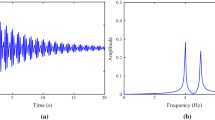Abstract
The objective of this paper was to develop an effective and efficient continuous health monitoring system. For this purpose, a novel improved ensemble empirical mode decomposition (EEMD) method has been introduced to decompose the nonlinear and non-stationary dynamic data. The improved EEMD method can commendably remove the noise from the original signals, and also it can alleviate the phenomenon of mode mixing. Then the reconstructed signal obtained after applying the improved EEMD technique was used to identify the continuous modal parameters such as frequency and damping ratio using the covariance-driven stochastic subspace identification method. The above techniques were then employed to the data obtained from a real-life cable-stayed bridge to identify its continuous modal parameters. The results validate that the proposed method is very effective in dealing with dynamic nonlinear and non-stationary data and can be used very effectually in real-life continuous health monitoring of cable-stayed bridges.









Similar content being viewed by others
References
Bonyapinyo V, Janesupasaeree T (2010) Data driven stochastic subspace identification of flutter derivatives of bridge decks. J Wind Eng Ind Aerodyn 98:784–799
Bonyapinyo V, Lauhatanon Y, Lukkunaprasit P (2006) Nonlinear aerostatic stability analysis of suspension bridge. Eng Struct 28(5):793–803
Entezami AR, Shariatmadar H (2015) New sensitivity-based methods for structural damage diagnosis by least square minimal residual techniques. Iranian J Sci Technol Trans Civil Eng 39(C2):231–251
Flandrin P, Rilling G, Gonçalvès P (2004) Empirical mode decomposition as a filter bank. IEEE Signal Proc Lett 11:112–114
Flandrin P, Gonçalvès P, Rilling G (2005) EMD equivalent filter banks, from interpretation to applications. In: Huang NE, Shen SSP (eds) Hilbert-Huang transform: introduction and applications. World Scientific, Singapore, pp 67–87
Gledhill RJ (2003) Methods for investigating conformational change in biomolecular simulations. A dissertation for the degree of Doctor of Philosophy at Department of Chemistry, the University of Southampton, p. 201
Goethals I, Mevel L, Moor BD (2004) Recursive output only subspace identification for in flight flutter monitoring. The 22nd International Conference, Dearbon, Michigan, US
Gu M, Qin XR (2004) Direct identification of flutter derivatives and aerodynamic admittances of bridge decks. Eng Struct 26:2161–2172
Huang NE, Shen Z, Long SR, Wu MC, Shih EH, Zheng Q, Tung CC, Liu HH (1998) The empirical mode decomposition method and the Hilbert spectrum for non-stationary time series analysis. Proc R Soc Lond 454A:903–995
Huang NE, Shen Z, Long SR (1999) A new view of nonlinear water waves: the Hilbert spectrum. Annu Rev Fluid Mech 31:417–457
Kaveh A, Mohammadi S, Hosseini KO, Keyhani A, Kalatjari VR (2015) Optimum parameters of tuned mass dampers for seismic applications using charged system search. Iranian J Sci Technol Trans Civil Eng 39(C1):21–40
Khan IU, Shan DS, Malik K (2014) Covariance driven subspace identification technique for continuous modal parameters identification of sutong bridge. IABSE Madr Symp Eng Progr Nat People 8:2666–2673
Khan IU, Shan DS, Li Q, He J, Nan FL (2015) Data interpretation and continuous modal parameter identification of cable stayed bridge. Open Civil Eng J 9:577–591
Lanslots J, Rodiers B, Peeters B (2003) Automated pole-selection: proof-of-concept and validation. LMS International, TST Technology Deployment and Research Researchpark Z1, Interleuvenlaan 68, B-3001, Leuven, Belgium
Liu YC, Loh CH, Ni YQ (2012) Stochastic subspace identification for output-only modal analysis: application to super high-rise tower under abnormal loading condition. Earthq Eng Struct Dyn 42:477–498
Mishra SS, Kumar K, Krishna P (2006) Identification of 18 flutter derivatives by covariance driven stochastic subspace method. Wind Struct 9(2):159–178
Overschee PV, Moor BD (1996) Subspace identification for linear systems: theory—implementation applications. Katholieke Universiteit Leuven, Belgium, Kluwer Academic Publishers, Boston/London/Dordrecht
Saberi M, Kaveh A (2015) Damage detection of space structures using charged system search algorithm and residual force method. Iranian J Sci Technol Trans Civil Eng 39(C2):215–229
Sivandi PA, Gerami M, Kheyroddin A (2015) Determination of modal damping ratios for non-classically damped rehabilitated steel structures. Iranian J Sci Technol Trans Civil Eng 39(C1):81–92
Teng JG, Ko JM, Tommy HT, Ni YQ (2003) Third generation structures: intelligent high-performance structures for sustainable urban systems. In: Proceedings of international symposium on diagnosis, treatment and regeneration for sustainable urban system, pp. 41–55, Japan
Wu Z, Huang NE (2003) A study of the characteristics of white noise using the empirical mode decomposition method. Center for Ocean-Land-Atmosphere Studies 4041 Powder Mill Rd., Suite 302, Calverton, MD 20705
Wu Z, Huang NE (2004) A study of the characteristics of white noise using the empirical mode decomposition method. Proc R Soc Lond 460A:1597–1611
Wu Z, Huang NE (2005) Ensemble Empirical Mode Decomposition: a noise assisted data analysis method. Adv Adapt Data Anal 1(1):1–49
Wu Z, Huang NE (2009) Ensemble empirical mode decomposition: a noise assisted data analysis method. Adv Adapt Data Anal 1(1):1–41
Acknowledgments
The research has been conducted as part of the result of a series of research projects granted by the National Key Basic Research and Development Plan (973 Program) with 2013CB036302, National Science Foundation with 51078316, Sichuan Science and Technology Program with 2011JY0032, Railway Ministry Science and Technology Research and Development Program with 2011G026-E and 2012G013-C.
Author information
Authors and Affiliations
Corresponding author
Rights and permissions
About this article
Cite this article
Khan, I., Shan, D. & Li, Q. Continuous Modal Parameter Identification of a Cable-Stayed Bridge Based on Robustious Decomposition and Covariance-Driven Stochastic Subspace Identification. Iran. J. Sci. Technol.Trans. Civ. Eng. 40, 11–22 (2016). https://doi.org/10.1007/s40996-016-0008-1
Received:
Accepted:
Published:
Issue Date:
DOI: https://doi.org/10.1007/s40996-016-0008-1




